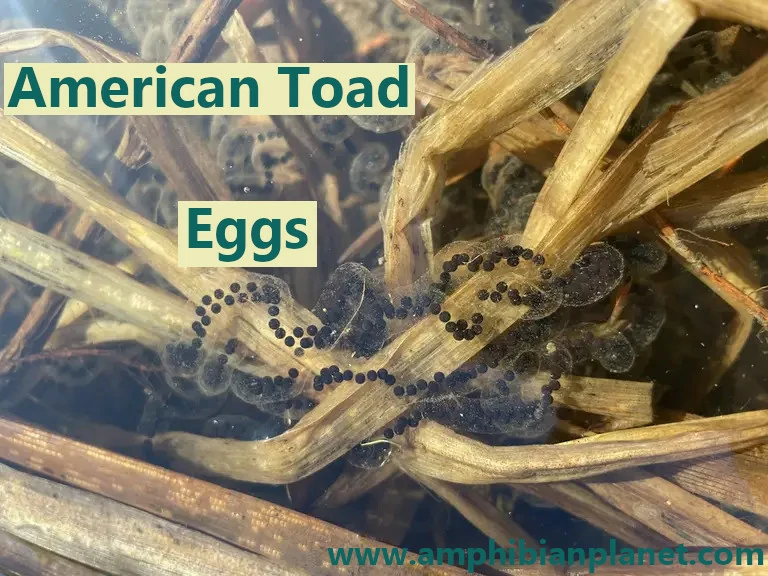American toads ((Anaxyrus americanus) are the most broadly distributed species of true toads (Bufonidae) in North America. They can be found in most areas of eastern Canada and the United States.
Like most toads, American toads reproduce by laying eggs. The eggs are laid in jelly-like strings, along plants, or on the bottoms of shallow water in ponds.
Learning about American toad eggs is great to add to your knowledge and feed your curiosity. Read on to find out everything you need to know about American toad eggs including some really interesting facts, as well as how to easily identify them.
When Do American Toads Lay Their Eggs?
The breeding season of American toads is triggered by the arrival of warmer temperatures and longer days.
In most of their range, this is from March to July, depending on the latitude.
However, American toads in the Southeast may begin breeding as early as mid-January or February.
American toads often breed earlier than other toads.
Where Do American Toads Lay Their Eggs?
American toads prefer to lay their eggs in shallow, standing, or slow-moving, temporary, or semi-permanent freshwater bodies with little to moderate amounts of vegetation.
Breeding sites include woodland ponds, flooded fields, seasonal pools, temporary rain puddles, flooded ditches, lake edges, river backwaters, open marshes, swamps, artificial ponds, and even deep tire tracks or potholes filled with rainwater.

Like many other amphibians, American toads prefer to breed in waters that are free of predatory fish. They will typically avoid water with fish, as fish often prey on amphibian eggs and larvae.
American toads have some measure of breeding site fidelity, and will sometimes return to the same breeding site every year.
How Do American Toads Lay Their Eggs?
The males arrive first at the breeding sites and call for mates, usually beginning in the early evening. They will also call during the daytime on warm and humid days at the height of the breeding season.
Females appear at the breeding sites from a few days to one week after the males.
Once at the breeding sites, female American toads will choose their mates depending on individual characteristics of the males’ calls – and head towards the calls of particular males.
The male then grasps her behind her forelimbs in a tight mating embrace called ‘amplexus’.

Occasionally, more than one male will grab onto a female and a small mating ball will form. This can be dangerous – as the female may drown because she cannot get to the water’s surface to breathe.
Once in the amplexus embrace, the pair will swim around as the female chooses a site to lay her eggs. The female then lays her eggs in jelly-like strings, and the male releases sperm into the water, to fertilize the eggs as the female lays them.
The egg strings attach to vegetation or lie at the bottom of the water.
How Many Eggs Do American Toads Lay?
A single female American toad can lay anywhere from 2,000 to as many as 20,000 eggs at a time.
In many toad species, female fecundity (capability to produce offspring) is positively correlated with size, so large female American toads may lay more eggs than smaller females.
Why Do American Toads Lay So Many Eggs?
Like many other toads (and frogs), American toads lay large numbers of eggs as a natural way to counter the extremely high mortality rates they experience in their early life stages.
American toads leave their eggs shortly after laying them. This means the eggs (and tadpoles) are vulnerable to predators, and environmental conditions – leading to very low survival rates.
Of the tadpoles that hatch, there will be intense competition for food and limited resources, meaning again the number of tadpoles will naturally thin out.
When the toadlets leave the water, only a few will live to adulthood and reproduce. The rest will get eaten by predators such as snakes, raccoons, and a wide variety of birds.
The large number of eggs laid by each toad is crucial to the survival of its species. If just 2 out of 1000 eggs laid become adult toads and live long enough to breed, the population of that species should increase.
What Do American Toad Eggs Look Like?
American toad eggs are black and surrounded by a clear jelly. They are laid in double, gelatinous strands and look almost like jelly-coated necklaces.
Here is what American toad eggs look like:


When first laid, the eggs are very tightly packed together. Over time, the jelly surrounding the eggs absorbs water until each egg is covered with a thick jelly coating.
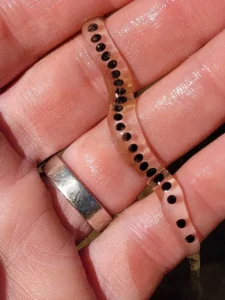
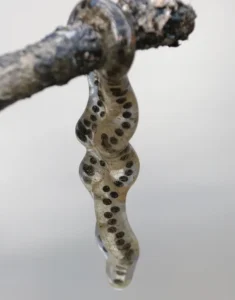
This enables the eggs to float near the surface of the water, where it is warmer and there is more oxygen.

Sometimes, the egg strings coil up like an old phone cord. The jelly strings help anchor the eggs to rocks and vegetation underwater, to prevent them from washing away.

Over time, sediment may settle on the egg strands, covering individual eggs and making the strands look like giant worms.



How Long Do American Toads Take To Hatch?
American toad eggs take about 3 to 14 days to hatch, depending on the environmental conditions. The eggs will typically develop and hatch faster in warmer temperatures and slower in colder temperatures.
American toad eggs laid in cooler weather will usually take longer to hatch than those laid in warmer weather.
What Do American Toad Tadpoles Look Like?
American Toad tadpoles are small, ranging from 0.7 to 1 inch (18 to 27mm) in length. They have a blackish-brown coloration, with a clear fin tail.
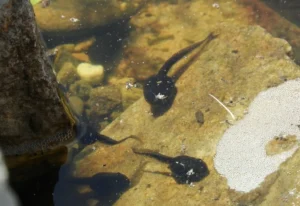



Young American toad tadpoles can easily be recognized by their skinny tails in relation to the size of their bodies.
They can often be seen swimming close together in schools in the shallow parts of their pond.
American Toad Eggs vs Frog Eggs
American toads and many frog species often lay eggs in the same pools.
However, distinguishing American toad eggs from frog eggs is fairly easy.
Most frogs lay their eggs in large clusters. The eggs look like jelly-like globs, with a developing embryo visible inside each egg.
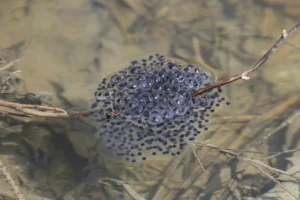

Some frogs also lay their eggs singly, often attached to the same stick in a pool.
On the other hand, American toads (and most other toads) lay their eggs in long jelly-covered strings, which may look like a string of black beads. No North American frog or European frog species lay their eggs in strings.

If you live in North America, Europe, or Australia and see amphibian eggs laid in long strings in the water, you can be 100% sure they are toad eggs.
Once you are sure they are toad eggs, you can ID them to see whether or not they belong to American toads.
What Animals Prey on American Toad Eggs and Tadpoles?
Like the eggs of many toad species, American toad eggs are toxic, and are therefore avoided by many potential predators.
American toad tadpoles also exude a toxic substance that is poisonous to at least some of their potential predators. However, they are still preyed on by
- Larvae of predaceous diving beetles (Dytiscidae)
- Newts (Notophthalmus)
- Dragonfly naiads
- Giant water bugs
- Crayfish
- Some birds such as Least sandpipers

What to Do if You Find American Toad Eggs
If you live near a wooded area, especially near a pond, or another water body there’s a chance of encountering American toad eggs in the spring. If this happens, be sure to avoid disturbing the eggs.
Disturbing or removing the eggs from the water could damage them, or even kill the tiny embryos developing inside the eggs.
If you find American toad eggs out of the water, it is best to leave them alone, especially if they are very near the water.
However, if you find toad eggs that were disturbed (by a human or animal) and taken out of the water, you could try to put them back in the water.
If the egg mass is still attached to a stick, very gently put the stick back in the water (just a few inches below the surface).
Still, the eggs are not guaranteed to hatch because the disturbance may have damaged them or killed the embryos developing inside.
Of course, there’s no harm in observing toad eggs from a distance.
Featured image credit: Olivia Gaetz (CC BY-NC 4.0 DEED)
Sources:
BRUCE WALDMAN, JOHN E. RICE, RODNEY L. HONEYCUTT, Kin Recognition and Incest Avoidance in Toads, American Zoologist, Volume 32, Issue 1, February 1992, Pages 18–30, https://doi.org/10.1093/icb/32.1.18
Stebbins, Robert C. (1951). Amphibians of western North America. University of California Press
Gerhardt, H.C. Sound pressure levels and radiation patterns of the vocalizations of some North American frogs and toads. J. Comp. Physiol. 102, 1–12 (1975). https://doi.org/10.1007/BF00657481

